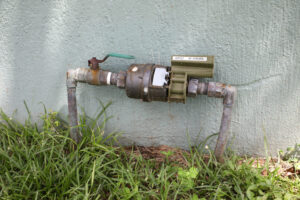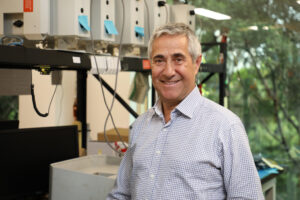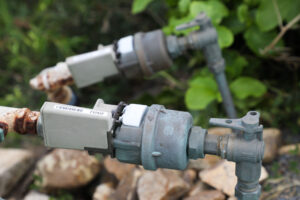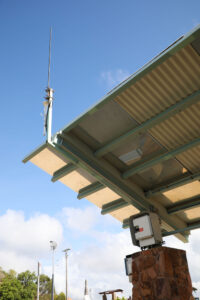Granular data on the volume and timing of water use is of great value to water providers and companies. Unfortunately, it can be hard to gather. Water meters are often located in difficult-to-reach or inhospitable environments. Taggle Systems is one company working to solve this problem. With its proprietary low-power radio system and its rugged devices, it can gather regular data from water meters in extremely hot, tropical environments—or from the water meters in your municipal or company system.
In this interview, John Quinn, the managing director of Taggle Systems, speaks with Municipal Water LeaderManaging Editor Joshua Dill about his company’s innovative and rugged technology.
Joshua Dill: Please tell us about your background and how you came to be in your current position.
John Quinn: I started my career in technology, initially as a business analyst in information technology. As my career progressed, I moved into sales and marketing, which gave me the ability to craft solutions for specific customer problems. When the opportunity with Taggle was presented to me, the company’s technical capabilities and the opportunity to provide solutions to the particular problems faced by the water sector was compelling.
Joshua Dill: Would you give us an overview of Taggle’s history and what it does?
John Quinn: The concept that originally gave Taggle its start was to monitor and locate cattle via radio- enabled ear tags. Cattle don’t like weight on their
ears, so reducing the tags’ weight was paramount. This necessitated using as small a battery as possible, which led the company to develop expertise in low-power solutions. Working with farming communities, however, is a particularly difficult challenge. The first part of that challenge is figuring out how to connect with them. The farming community is diverse and is spread all over the country, so building a sales and marketing plan to reach them and then making that business model commercially viable was difficult.

As a result, Taggle looked for other opportunities to use its great low-power radio technology and worked out that water meters presented a good opportunity. Why water meters? First of all, there’s one on every house in Australia. Second, they’re near water, so electric devices are not a good idea. Third, water meters tend to last for a long time, so building a long-lasting, radio-controlled device to sit on the side of a water meter seemed like a really good use of the technology.
The company went looking for monitoring facilities that had problems that it could address and came across the Mackay Regional Council in North Queensland. The Mackay Regional Council was particularly interesting to work with because it was a fast-growing community. It had a significant mining industry, and it was located in the tropics, so although there was quite a large available source of water, that water was challenging to treat. The Mackay Regional Council faced what were huge expenditures for a relatively small community to build a water treatment plant. It was an A$100 million (US$69.7 million) water treatment plant, which was on its future capital expenditure requirement. If we were able to use our radios to read its water meters more frequently, we could assist the council with leak detection and to help it better engage with the community and improve water demand management. In Australia, as in most places, most water is used outside, for watering gardens and lawns and for washing driveways. Our aim was to help the community remove leaks from its system, particularly on the customer side, and to improve and reduce the use of outdoor water. Our initial project with Mackay Regional Council was a brilliant success. The council saw significant reductions in water consumption. That was Taggle’s entry into the water business.
Joshua Dill: Taggle works in both agricultural and municipal settings. Did it require a lot of work to adapt the technology to those different uses?
John Quinn: The water utility set the scene. It was in a very inhospitable environment. Water meters are frequently located outdoors, and Mackay Regional Council in particular is located in the hot tropics, which implies a bunch of issues. It sees outdoor temperatures of about 45° C (113° F). The water meters are brass, and they are located 8 inches above the ground, so they get even hotter. A large amount of our product development was aimed at building robust devices that can withstand that challenging environment. With early versions of the product, we experienced difficulties with plastics and polymers expanding in the heat, so we had to find heat-resistant materials. We had to make them waterproof, because the devices are located outdoors and the area floods. We had to deal with battery failures. The temperatures are terrible for batteries. Many simply aren’t manufactured to withstand the temperatures we subject them to here.
Our radio is an extremely low-power device. We work in the license-free spectrum area, so we do have to build products that work cooperatively in environments where other devices play. Because of that, we’ve built our technology to have smart capabilities. We’ve developed strong capabilities in the receiver part of the radio. Although our radios are dumb and simple, the receivers are very smart. We’ve had to build capabilities like interference mitigation into our receivers.
 We have also made the decision, particularly in the last 3-4 years, to focus on the water sector. That goes beyond just water meters. Increasingly, in the water space, we’ve been asked to monitor and collect data from a vast range of technologies. We’ve been working on wastewater management, including things like sewerage monitoring devices, pressure sensors (high pressure events are often a precursor to burst water mains), water quality sensors, gas sensors, and hydrogen sulfide sensors. To do this, we needed to make some decisions about how we managed connectivity to those devices. We’ve built into our products the ability to pick up a pretty wide range of standard sensors. We’re able to connect quickly and easily to sensors via technologies like 4-20 milliamp (mA) or serial or pulse counts. We also have a platform that translates data into usable forms. A 4-20 mA device will report to you in mA, but most people need a sensor reading in parts per million, millibars, or kilopascals. We connect our radio to the device using a standard interface, collect the data from the device, and send it to the user in a usable form.
We have also made the decision, particularly in the last 3-4 years, to focus on the water sector. That goes beyond just water meters. Increasingly, in the water space, we’ve been asked to monitor and collect data from a vast range of technologies. We’ve been working on wastewater management, including things like sewerage monitoring devices, pressure sensors (high pressure events are often a precursor to burst water mains), water quality sensors, gas sensors, and hydrogen sulfide sensors. To do this, we needed to make some decisions about how we managed connectivity to those devices. We’ve built into our products the ability to pick up a pretty wide range of standard sensors. We’re able to connect quickly and easily to sensors via technologies like 4-20 milliamp (mA) or serial or pulse counts. We also have a platform that translates data into usable forms. A 4-20 mA device will report to you in mA, but most people need a sensor reading in parts per million, millibars, or kilopascals. We connect our radio to the device using a standard interface, collect the data from the device, and send it to the user in a usable form.
We’ve had a great deal of interest in this from the water sector because companies operating in that sector don’t know quite what areas these sensors will provide value in. The future value of collecting this data may be in areas they don’t understand yet. It could be useful for early warning: If you detect an overflow in a sewage network, you can potentially send a maintenance crew out before the sewage ends up damaging the environment. There are many other advances that I think are possible. For example, we collect 24 readings a day from water meters. You don’t need that many from a billing point of view, but it is advantageous for leak detection. It also provides a municipality information about water use at different times of day. That information can offer big advantages. For example, if you are building water main infrastructure for a community, you’ve got to assume that the entire community is using the infrastructure all the time. You have to plan for peak use. But when you know through measurement that the community does not in fact use all the water all the time, you can calculate much more realistic sizing requirements. That can lead to reductions in pipe size throughout a municipality. Around the western world, we’ve got pipe infrastructure that has been underground for 100 years now. If you can take a 300-millimeter (mm) water main, and instead of digging it up to replace it, sleeve it with a 200-mm sleeve, the implications are enormous.
Joshua Dill: Is all your hardware and software proprietary?
John Quinn: Our radio network is Taggle developed, including everything from the chip to the receiver, the cloud platform, and the delivery. I hesitate to say that our platform is proprietary—it is, but it has open connectivity. On the sensor side, we connect to most of the standard interfaces used by utilities: 4-20 mA, serial, pulse output, Modbus, etc. We don’t build sensors; we connect to sensors built by other people. On the data-delivery side, we deliver data in any format a user wants—for example, comma- separated values files or web services solutions. We have connectivity to the large integration platforms, like Amazon Web Services or Microsoft Azure. We worked hard to make sure that people wouldn’t have to bend themselves out of shape to use our solution. We don’t care what brand of sensor or what sort of water meter you want to use. In the United States, we use the U.S. Sensus radio frequency protocol. We can connect to any water meter.
Power is the thing that generates most of the costs in systems like ours. The size of the battery is the issue. The battery accounts for a significant part of the cost, and it determines how long the device lives. We build devices that can last 20 years on battery power in the field, delivering data every hour. You need a very low-power device to be able to do that.

Joshua Dill: Where are your products being used today?
John Quinn: Most of our clients are in Australia. We’ve done some small trial implementations in Raleigh, North Carolina, with Honeywell. We’ve also worked with Honeywell in Brazil. In Australia, we’ve done a large number of installations. In the 2018 calendar year, we delivered 1.4 billion water meter readings in Australia.
Joshua Dill: Would you tell us about your sales and marketing process?
John Quinn: In Australia, we work closely with Honeywell, which probably has 70 percent of the Australian water meter market. The biggest companies by far are Honeywell and Itron. Many of the companies present in the United States are not present in Australia.

We have also worked with Honeywell on some technical developments. We built an integrated water meter for the Australian market called the V200HT, which was engineered largely in the United Kingdom. It’s a hybrid meter: It’s got a mechanical base, a digital register, and a radio. The radio in this model is built into the meter itself. No add-on radio is required. It is robust. We’ve done well with it. We launched that product only a few months ago, and we’ve got a backlog of about 60,000 orders already.
Joshua Dill: What is your vision for the future?
John Quinn: We’re going to continue to develop a deep understanding of the water sector and our marketplace. We think there’s a lot of scope there. With all the water meter companies and utilities in Australia, there is a very diverse utility marketplace. It includes municipal councils and separate independent water utilities. We think that building a fully supportable environment from sensor to software has real value here.
We’re also actively looking at international partnerships. Water security, demand management, and the cost of delivery are global problems. California has significant issues with water supply that mirror the water supply problems we have in vast parts of Australia. Drought is something we’re familiar with. Cape Town, South Africa, is reportedly running out of water. The solutions we offer have great value in those environments.
John Quinn is the managing director of Taggle Systems. He can be reached at enquiries@taggle.com.au. For more information about Taggle,
visit www.taggle.com.au.
